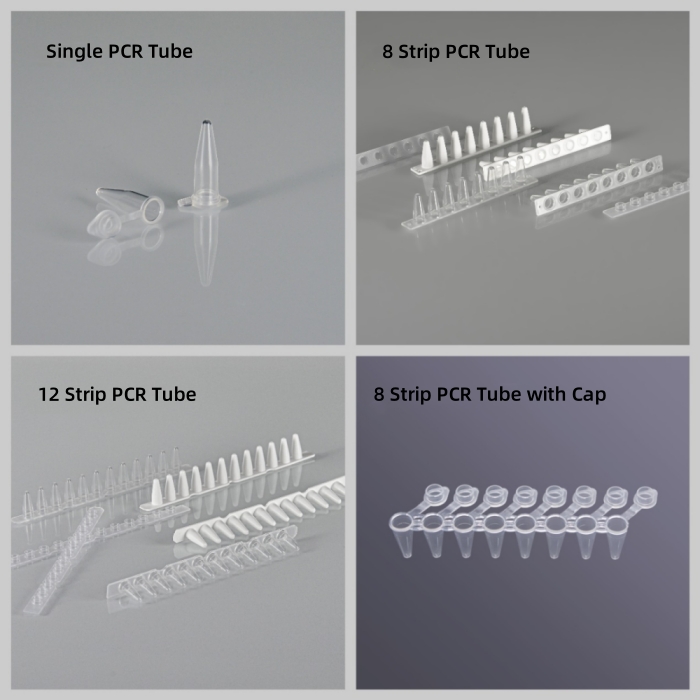PCR Tubes are key consumables in PCR experiments, and their selection directly affects the accuracy and stability of experimental results. This article will help you better choose the right PCR Tube from multiple perspectives, including the classification, volume, and color of PCR Tubes.
1. Classification
· Single PCR Tube: Suitable for testing single or small samples, simple operation, suitable for small-scale experiments;
· 8-strip PCR Tube: This is the most commonly used type of PCR tube, with 8 reaction spaces in a row, the number of uses can be flexibly adjusted according to experimental needs, and the operation is convenient;
· 8-strip PCR Tube with Cap: Each tube has an independent tube cap, which can be opened and closed separately to avoid cross contamination, especially suitable for experiments that require frequent opening of the cap;
· 12-strip PCR Tube: There are 12 reaction spaces in a row, the number of uses can be flexibly adjusted according to experimental needs, flexible operation, and the cost performance is better than 8-tube strip.
2. Volume
· 0.1ml PCR Tubes: small dead volume, less space above the reaction solution, can reduce the accumulation of water vapor, the reaction solution composition is more stable, and the experimental results are more reproducible;
· 0.2ml PCR Tubes: compatible with most PCR instruments, but the dead volume of small-volume experiments is large, and more water vapor accumulates, which may cause the reaction solution to concentrate, affecting the stability and accuracy of the experimental results;
Precautions:
If the PCR instrument is adapted to 0.2ml tubes, using 0.1ml tubes may cause the hot cover to fail to press the tube cover tightly, causing reagent evaporation and aerosol contamination;
If the PCR instrument is adapted to 0.1ml tubes, using 0.2ml tubes may damage the instrument.
3. Color
· Transparent PCR Tube
Advantages: High transmittance, suitable for PCR instruments with fluorescence detection module located below the heating module (bottom reading or side reading signal);
Disadvantages: In PCR instruments with top reading signals, transparent tubes have large fluorescence loss and low signal-to-noise ratio;
· Frosted PCR Tube
Advantages: Low transmittance, reduced fluorescence loss, higher signal-to-noise ratio than transparent tubes, suitable for PCR instruments with top reading signals;
Disadvantages: Not suitable for PCR instruments with bottom reading or side reading signals, lower signal-to-noise ratio than white PCR tubes;
· White PCR Tube
Advantages: Lowest transmittance, least fluorescence loss, highest signal-to-noise ratio, suitable for PCR instruments with top reading signals;
Disadvantages: The liquid surface cannot be seen during the experiment, not suitable for PCR instruments with bottom reading or side reading signals;
Suggestions:
For PCR instruments with top reading signals (such as Bio-Rad CFX, Roche 480), it is recommended to use white or frosted tubes; for PCR instruments with bottom reading or side reading signals (such as HONGSHI SLAN-96S, Molarry MA6000), only transparent tubes can be used.
Summary and Suggestions
1. Experimental scale: Single tube is suitable for small-scale experiments, 8-tube strips and 12-tube strips are suitable for medium- and large-scale experiments;
2. PCR instrument adaptability: Ensure that the volume of the PCR tube matches the thermal cover design of the PCR instrument to avoid reagent evaporation or instrument damage;
3. Fluorescence detection module position: PCR instruments with top reading signals are recommended to use white or frosted tubes, and PCR instruments with bottom or side reading signals can only use transparent tubes.
Post time: May-16-2025


